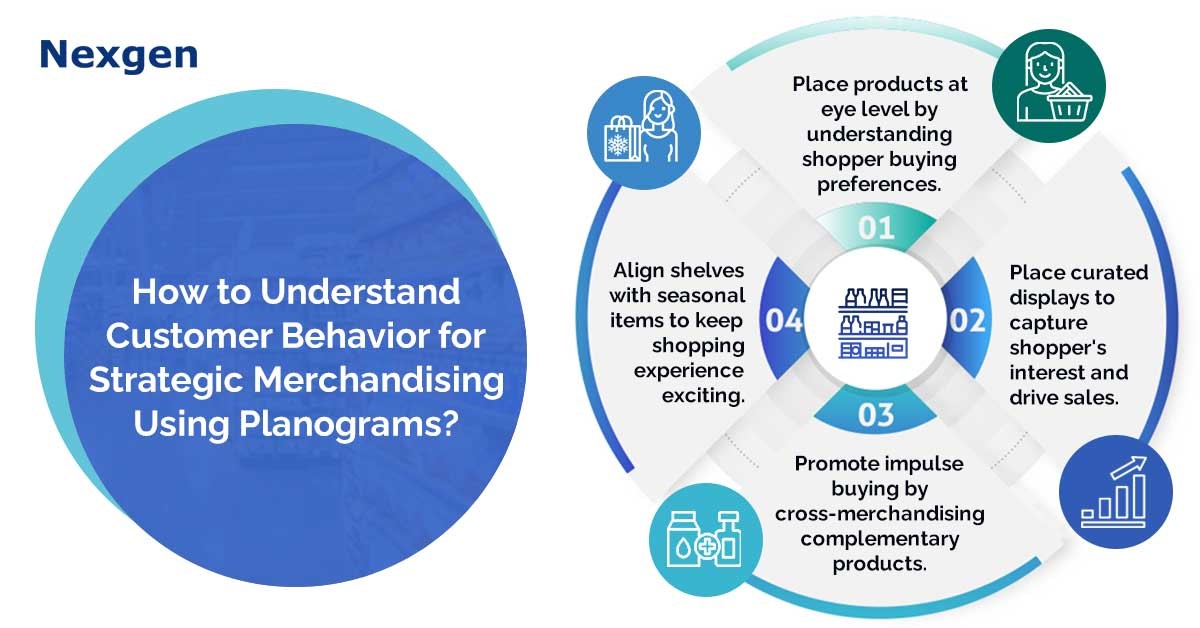In retail, understanding customer behavior is key to creating a shopping environment that not only attracts but also engages and converts visitors into buyers. Planogram is a powerful tool that retailers can leverage to influence customer behavior. By strategically designing shelf planning software, such as planograms, retailers can create a shopping experience that maximizes sales and enhances customer satisfaction.
The Importance of First Impressions in Retail Store Sales
The first few seconds of a customer's entry into a store are crucial. This is when first impressions are formed, and planograms play a significant role in shaping these impressions. A well-designed planogram not only catches the customer's eye but also guides them through the store in a logical and aesthetically pleasing manner. Following are some planogram ways to understand customer behavior for strategic merchandising:

- Strategic product placement: Understanding the psychology behind customer decision-making is essential for effective merchandising. Products strategically placed at eye level are more likely to be noticed and purchased. Planograms should consider the typical eye level of the target demographic to ensure that the most profitable items receive prime real estate on the shelves. As your customer steps through the entrance, they are immediately greeted by a sleek display showcasing the latest smartphones and smartwatches. This is no coincidence; it is a result of strategic product placement based on an understanding of customer decision-making psychology.
- Grouping and cross-merchandising: Planograms allow retailers to group complementary products together, encouraging customers to make additional purchases. Cross-merchandising creates a seamless shopping experience by placing related items in proximity. For example, displaying pasta sauce next to pasta or batteries near electronic devices can increase the likelihood of customers adding these items to their carts. For example, when your customer enters the grocery store, their attention is immediately drawn to a well-designed display featuring a variety of fresh fruits and vegetables. The store has grouped these complementary items together, creating a one-stop destination for customers looking to purchase both items. The fresh fruit shelves are neatly aligned with the corresponding vegetables, making it convenient for shoppers to find everything they need in one place.
- Navigating the customer journey: Understanding the customer journey within a store is vital for effective planogram design. Start by placing attention-grabbing products at the store entrance to capture interest. As customers progress through the store, strategically placed planograms should guide them to different sections, ensuring exposure to a diverse range of products. You can carefully place curated displays featuring impulse-buy items on checkout counters. Small accessories, travel-sized beauty products, and trendy gadgets can be strategically placed to catch your customer’s eye while they wait in line. These last-minute additions serve as a final opportunity for the store to boost sales and provide customers with enticing options.
- Seasonal and trend-driven planograms: Successful retailers stay ahead of trends and leverage the power of seasons to drive sales. Planograms should be adaptable to accommodate seasonal changes and capitalize on emerging trends. With the start of the new year, retailers can introduce planograms that reflect the latest fashion trends. Mannequins showcase outfits inspired by runway looks and display must-have accessories and colors of the season. Whether it is creating a festive display for the holidays or featuring the latest fashion trends, aligning planograms with the current season keeps the shopping experience fresh and exciting for customers.
- Influence of color and lighting: Planogram is not limited to the arrangement of products; it also extends to color schemes and lighting. Bright, inviting lighting can enhance the overall shopping experience, while strategically using colors can influence emotions and buying decisions. Warm tones can create a sense of comfort, while bold colors may grab attention and create a sense of urgency.
Overview of Nexgen POG
Nexgen POG is a robust and user-friendly cloud-based visual merchandising tool. It is designed for quick and efficient planogramming with minimal effort. Planogram in retail can be designed by easily dragging and dropping the products. The multi-device compatibility feature of POG allows you to obtain, share and edit planogram on any device, including your phone. It helps in designing store-specific planograms for increased product visibility and sales.
Get Your Free Trial Now!